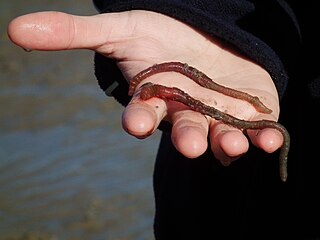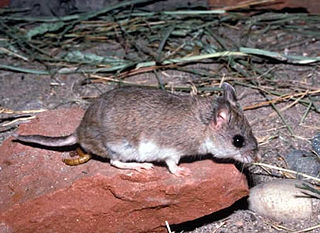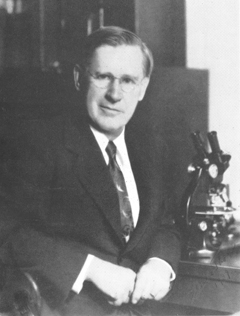
A mold or mould is one of the structures that certain fungi can form. The dust-like, colored appearance of molds is due to the formation of spores containing fungal secondary metabolites. The spores are the dispersal units of the fungi. Not all fungi form molds. Some fungi form mushrooms; others grow as single cells and are called microfungi.

Penicillium is a genus of ascomycetous fungi that is part of the mycobiome of many species and is of major importance in the natural environment, in food spoilage, and in food and drug production.

Blue cheese is any of a wide range of cheeses made with the addition of cultures of edible molds, which create blue-green spots or veins through the cheese. Blue cheeses vary in taste from very mild to strong, and from slightly sweet to salty or sharp; in colour from pale to dark; and in consistency from liquid or very soft to firm or hard. They may have a distinctive smell, either from the mold or from various specially cultivated bacteria such as Brevibacterium linens.

Leucorchestris arenicola, commonly called the dancing white lady spider, is a huntsman spider in the family Sparassidae and genus Leucorchestris. It is commonly found in the Namib desert of Namibia. It is often mistaken with the similarly named Carparachne aureoflava, or more commonly known as the wheel spider from the same location. L. arenicola relies on seismic vibrations, called drumming, for communication. It taps its foremost legs on the sand to send messages to other white lady spiders. Male L. arenicola will travel over 50 m in one night searching for a mate. If they find a mate, they must be extremely careful, for drumming the wrong message can be deadly. One of the major features that characterizes its nocturnal behavior is its specialized vision, using eight eyes in different orientations to capture a panoramic view of the surroundings. L. arenicola spiders use temporal summation in order to be able to see dim lighting during night-time wanderings. The species was first described by Reginald Frederick Lawrence in 1962, who described all the species in the genus Leucorchestris.

The Eurotiales are an order of sac fungi, also known as the green and blue molds. It was circumscribed in 1980.

The Trichocomaceae are a family of fungi in the order Eurotiales. Taxa are saprobes with aggressive colonization strategies, adaptable to extreme environmental conditions. Family members are cosmopolitan in distribution, ubiquitous in soil, and common associates of decaying plant and food material.

The tundra vole or root vole is a medium-sized vole found in Northern and Central Europe, Asia, and northwestern North America, including Alaska and northwestern Canada. In the western part of the Netherlands, the tundra vole is a relict from the ice age and has developed into the subspecies Alexandromys oeconomus arenicola.
Pseudoviridae is a family of viruses, which includes three genera.

The blow lugworm, also known as sandworm, is a large species of marine worm. Its coiled castings are a familiar sight on a beach at low tide but the animal itself is rarely seen except by those who, from curiosity or to use as fishing bait, dig the worm out of the sand.

Penicillium roqueforti is a common saprotrophic fungus in the genus Penicillium. Widespread in nature, it can be isolated from soil, decaying organic matter, and plants.
Hatena arenicola is a species of single-celled eukaryotes discovered in 2000, and first reported in 2005. It was discovered by Japanese biologists Noriko Okamoto and Isao Inouye at the University of Tsukuba, and they gave the scientific description and formal name in 2006. The species is a flagellate, and can resemble a plant at one stage of its life, in which it carries a photosynthesizing alga inside itself, or an animal, acting as predator in another stage of its life. Researchers believe that this organism is in the process of secondary endosymbiosis, in which one organism is incorporated into another, resulting in a completely new life form.

Mearns's grasshopper mouse or the Chihuahuan grasshopper mouse is a grasshopper mouse found in southwestern New Mexico, West Texas, and north-central Mexico. They are similar to Onychomys torridus, but differ in karyotype and size. This mouse is smaller in every regard except for the nasal length of the skull.

Penicillium chrysogenum is a species of fungus in the genus Penicillium. It is common in temperate and subtropical regions and can be found on salted food products, but it is mostly found in indoor environments, especially in damp or water-damaged buildings. It has been recognised as a species complex that includes P. notatum, P. meleagrinum, and P. cyaneofulvum. Molecular phylogeny has established that Alexander Fleming's first discovered penicillin producing strain is of a distinct species, P. rubens, and not of P. notatum. It has rarely been reported as a cause of human disease. It is the source of several β-lactam antibiotics, most significantly penicillin. Other secondary metabolites of P. chrysogenum include roquefortine C, meleagrin, chrysogine, 6-MSA YWA1/melanin, andrastatin A, fungisporin, secalonic acids, sorbicillin, and PR-toxin.

The fungi imperfecti or imperfect fungi are fungi which do not fit into the commonly established taxonomic classifications of fungi that are based on biological species concepts or morphological characteristics of sexual structures because their sexual form of reproduction has never been observed. They are known as imperfect fungi because only their asexual and vegetative phases are known. They have asexual form of reproduction, meaning that these fungi produce their spores asexually, in the process called sporogenesis.

Penicillium brevicompactum is a mould species in the genus Penicillium.

Charles Thom was an American microbiologist and mycologist. Born and raised in Illinois, he received his PhD from the University of Missouri, the first such degree awarded by that institution. He studied the microbiology of dairy products and soil fungi, and in particular researched the genera Aspergillus and Penicillium. His work influenced the establishment of standards for food handling and processing in the USA. He pioneered the use of culture media to grow microorganisms, and, with food chemist James N. Currie, developed a process to mass-produce citric acid using Aspergillus. Thom played an important role in the development of penicillin in World War II.

Arenicola, also known as sandworms, is a genus of capitellid annelid worms comprising the lugworms and black lugs.
Penicillium vanoranjei is an orange-colored fungus first described in 2013 from specimens collected in Tunisia. It was named after the Prince of Orange Willem-Alexander to commemorate his coronation as King of the Netherlands.
Penicillium citrinum is an anamorph, mesophilic fungus species of the genus of Penicillium which produces tanzawaic acid A-D, ACC, Mevastatin, Quinocitrinine A, Quinocitrinine B, and nephrotoxic citrinin. Penicillium citrinum is often found on moldy citrus fruits and occasionally it occurs in tropical spices and cereals. This Penicillium species also causes mortality for the mosquito Culex quinquefasciatus. Because of its mesophilic character, Penicillium citrinum occurs worldwide. The first statin (Mevastatin) was 1970 isolated from this species.












